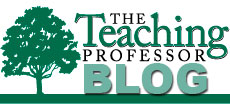
http://www.facultyfocus.com/articles/teaching-professor-blog/prompts-that-get-students-to-analyze-reflect-relate-and-question/
August 28, 2013
Prompts That Get Students to Analyze, Reflect, Relate, and Question

A simple teaching technique that helps students learn; now there’s something few teachers would pass up! This particular technique involves a four-question set that gets students actively responding to the material they are studying. They analyze, reflect, relate, and question via these four prompts:
- “Identify one important concept, research finding, theory, or idea … that you learned while completing this activity.”
- “Why do you believe that this concept, research finding, theory, or idea … is important?”
- “Apply what you have learned from this activity to some aspect of your life.”
- “What question(s) has the activity raised for you? What are you still wondering about?” [You might need to prohibit the answer “nothing”.]
The question set is versatile. Here are some examples of how it could be used.
- Use the four prompts as a way to summarize an in-class discussion, adjusting the wording of the questions: “Identify one important idea that you learned during this discussion,” etc.
- Have students answer the questions about a reading assignment. Dietz-Uhler and Lanter had students write 100-word responses to the first three prompts. Written answers could be shared in small group discussions.
- At the beginning of class, give students five minutes to write answers to the questions as a way of reviewing notes taken in a previous class session. Or, have students submit answers online before class and use sample responses to review the material.
- A version of the question set could be the template used to provide peer feedback on a paper. (What’s one important idea presented in this paper? Why does the author think the idea is important? Is that idea important to you? Why or why not? What question(s) do you think the author still needs answer?)
- Use the questions as way to end and evaluate a course. (What’s one important idea you’ll take from this course? Why do you believe it’s important? How does it relate to your life? What are the next questions you want to find answers to?) To answer these questions, students must reflect on their learning. Their answers might cause teachers to reflect as well.
If the technique is used in a dissimilar way the same results aren’t guaranteed, of course, but you can test your results. Short of an empirical analysis, you can ask students whether the questions enhanced their understanding. When asked, Deitz-Uhler and Lanter’s students said that they did. You also could decide to make a critical assessment of the questions’ effectiveness.
Sometimes I think we gravitate toward fancy techniques—the ones with lots of bells and whistles. It’s nice on occasion to wow students, but it’s not always necessary. A technique like this showcases a simple but useful way students can interact with the content. It’s a teaching technique that becomes a study strategy capable of moving students toward thinking and learning on a deeper level.
References: Dietz-Uhler, B. and Lanter, J. R. (2009). Using the four-questions technique to enhance learning. Teaching of Psychology, 36 (1), 38-41.
Alexander, M. E., Commander, N., Greenberg, D., and Ward, T. (2010) Using the four-questions technique to enhance critical thinking in online discussions. Journal of Online Learning and Teaching, 6 (2), 409-415.